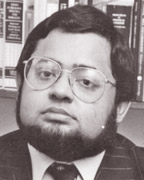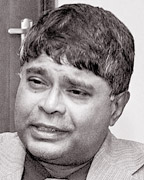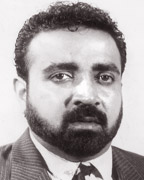Liberal Party celebrates Silver Jubilee
by Kamal NISSANKA

Dr. Chanaka Ameratunga |

Dr. Rajiva Wijesingha |
 |
| Asitha Perera |
Political parties were not recognised in order to contest elections
at the introduction of Universal suffrage under the Donoughmore
Constitution but political groupings were visible within the political
space and the electoral mechanism. Four significant political groupings
in the first ever election to the State Council were Labour Party,
Ceylon National Congress, Unionists and the Liberal League under the
leadership of E.W. Perera, the Lion of Kotte.
Liberal League contested in Colombo Central, (T.B. Jayah), Colombo
North (R. Saravanamuttu- won), Dumbara (J.A. Halangoda), Gampola. (T.B.
Panabokke-won), Hatton (P. Sundaram-won), Horana (E.W. Perera-won) Kandy
(F.A. Senevirathne), Kalutara (C. Batuwanthdawe-won), Katugampola (R.S.
Tennekoon-won), Mannar-Mullaitivu (G.G. Ponnambalam), Matale (W.T.B.
Karalliyadda-won), Matara (J.H.P. Wijemanne), Narammala (G.E. Madawala-won),
Nuwaraeliya (E.W. Abeygoonasekara-won), Puttalam (F.C.S. Storer),
Ruwanwella (J.H. Meedeniya-won), Weligama (D. Wanigasekara-won) and was
looked as a formidable force in the beginning of the Donoughmore period.
However as the Donoughmore system did not allow the development of
political parties and for various other reasons, Liberal League
gradually disappeared by 1936, Ceylon National Congress remained the
major force in politics in the third decade of the 20th century.
There is no doubt that early liberals had been influenced by the
Liberal Party of the United Kingdom (UK) but in the 1930’s the Liberal
Party of UK was diminishing as a major political contender as a result
of a major split and two major groups of liberals joined the
Conservative Party and newly formed Labour Party and thus ending the
dominance of the Liberal Party. Only in 2010 British Liberals were able
to enter the government almost after 80 years.
Second phase
Second phase of liberal politics began in Sri Lanka with the
formation of the Liberal party on the January 19, 1987 which was later
registered under the Election Commissioner in 1988. The forerunner to
the party was Council of Liberal Democracy that was organised by a group
of upper middle class educated youths to agitate against authoritarian
tendencies of the J.R. Jayewardene government manifested in the ill
famous referendum to extend the duration of the Parliament that was
elected in 1977.
Founder leader of the Liberal Party was Dr. Chanaka Ameratunga, a
young intellectual who had completed his studies from the Oxford
University and London School of Economics.
Liberal Party constitution categorically states that the party stands
for the ideology of liberalism as opposed to populism, socialism and all
types of nationalism. Liberals believe that the task of the state is to
widen individual freedom that has a direct impact on development.
Under Chanaka
During the 25 years the Liberal Party came under three leaders. Dr.
Chanaka Ameratunga was the undisputed leader of the party until his
untimely death in 1996. The nine years record the interaction of the
party in various political issues with special emphasis on
constitutional reforms. It had, limited electoral success at the first
ever provincial council election in 1988.
At the Gampaha district owing to the reason that Sri Lanka Freedom
Party did not contest the election the Liberal Party won two seats.
Chanaka’s overall strategy was to enter the Parliament through an
alliance against J.R. Jayewardene regime that worsened the national
question as well as the principles of democracy.
Though the party played a vital role with late Kumar Ponnambalam in
drafting election manifesto of Mrs. Sirimovo Bandaranaike in 1989,
United National Party once again emerged the victorious party.
Though Chanaka was a national list candidate under SLFP, there was no
opportunity to be elected. With change in leadership of the United
National Party in 1989 Liberal Party was leaning towards UNP in order to
have an alliance and this came to end with the tragic death of R.
Premadasa.
After the demise of R. Premadasa then leaders, D.B. Wijetunga and
Ranil Wickremesinghe did not tolerate such an alliance with the Liberal
Party.
In 1994 general election Liberal Party formed an official alliance
with the Sri Lanka Muslim Congress under the leadership of late. A.H.M.
Ashroff and to his credit he wanted to keep the promises alive. However
Mrs. Chandrika Kumaratunga was determined not get Chanaka in and also a
segment of the Muslim Congress high command was also opposing Chanaka’s
entrance into Parliament and subsequently Asitha Perera, Senior Vice
President of the Liberal Party was nominated as first ever Liberal Party
member of Parliament through the national list of the Muslim Congress.
In the 1994 presidential election Liberal Party decided to support UNP
candidate. Gamini Dissanayake, Liberal Party Leader was instrumental in
drafting Dissanayake’s manifesto.
Assassination of Dissanayake by the LTTE ended up the loose alliance
with. Gamini Dissanayake. Chanaka’s tragic death in 1996 ended the first
phase of the liberal Party. Mrs. Swarna Amaratunga, Chanaka’s mother
joined the party and she now holds the post of president.
Rajiva as leader
In 1996 after Chanaka’s demise, the national committee of the Liberal
Party elected Dr. Rajiva Wijesinha, President of the party as the acting
leader unanimously. In 1997 the national congress endorsed the
leadership of Rajiva Wijesinha. Under his leadership it was decided that
the party should outreach and get many organizers from the outstations.
As a result of this decision Liberal Party wanted to contest the 1999
Presidential election and Rajiva was the candidate and also contested
the 2000 general election in almost all districts.
All subsequent elections were contested by the party at selected
districts. Worth to mention is Rathnapura Municipal election in the
2002. During the period of Rajiva’s tenure party got electoral successes
in Dompe(PS), Kobeigane(PS) and Gampaha(MC). The party in 2005 was to
take a stand on the presidential election and was of the opinion that
UNP was unable to face the challenge posed by LTTE and decided to
support the new candidate of the SLFP Mahinda Rajapakse. The party was
involved in the UPFA campaign through. Kamal Nissanka then the Secretary
General.
Kamal
After 10-years in leadership Rajiva opted to step down and the party
unanimously decided to appoint Kamal Nissanka, a graduate from the
University of Peradeniya and an Attorney-at-Law as the third leadership
of the party.
Under Nissanka’s leadership party was able to maintain very good
rapport with SLFP and UPFA in 2010 he was able to negotiate with SLFP
and UPFA to get a national list seat for the party and party decided to
propose Rajiva Wijesinha as its nominee and informed the Secretary
General of UPFA, Susil Premajayantha.
During the period concerned Liberal Party was offered the
chairmanship of the Council of Asian Liberals and Democrats(CALD)
composed of 12 Asian political parties. During this period international
image of the party was grown.
Under Nissanka’s tenure party’s organisational structure was also
developed and it has now a workers union, youth wing and women’s wing.
Party has increased the membership of the national committee, the
highest decision making body up to 23 members.
In the last congress of the party held on December 18, 2011, party
unanimously elected Prof. Rajiva Wijesinha, MP as the leader considering
his presence in the parliament and in order to promote the party’s
national image. Nissanka continues to serve as the secretary general and
the de facto national organiser of the Liberal Party.
Liberal Party has now decided to organise the party in more positive
manner as the policies of some major parties are outdated. |

